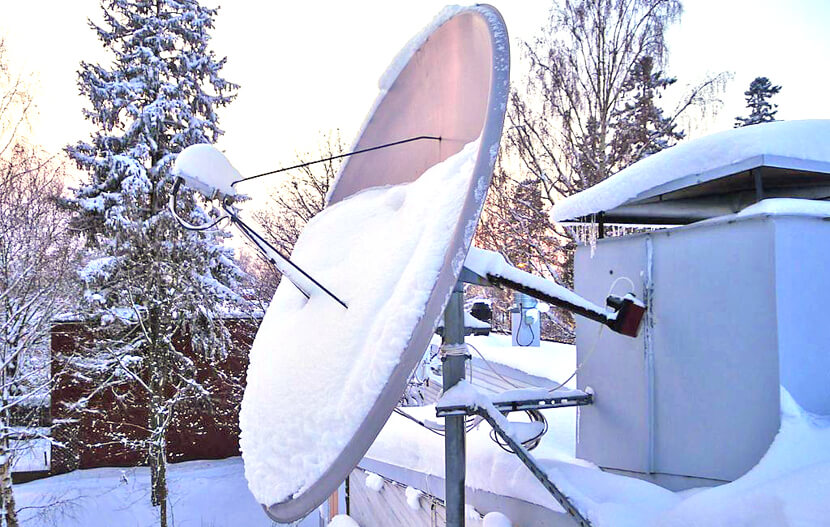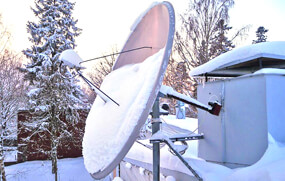
Snow and ice on your satellite dish will affect TV reception. To ensure you maintain good reception throughout the winter months, fit a satellite dish heater. Dish heaters are a flat metal heating element that keeps the temperature of the dish above freezing and so snow and ice will slide off.
Will snow on a satellite dish affect reception
Satellite reception for HD and even 4K is generally exceptional in most locations. Satellite TV has one big drawback over cable or IPTV, and that is they are prone to reception problems due to adverse weather.
If you live in California, you are unlikely to be troubled by weather, but in colder climates, this becomes much more of a problem. Snow building up on the dish will effectively block the signal collected by the LNB. The LNB (Low-Noise Block Downconvertor) is the signal collector that usually sticks out in front of the dish.
With particularly heavy snowfall the weight of snow can even move the dish out of alignment.
Before setting foot outside your house to inspect the dish, sometimes you can successfully tune your receiver to the SD version of the same HD channel.
You will usually find that the larger the dish, the more susceptible it will be to retaining snow because of the surface area. Luckily a lot of the modern slimline dishes are quite small and so don’t collect as much as their larger counterparts.
[adinserter name=”Dish Heater”]Can you brush snow off a satellite dish?
If your dish is accessible, you can brush snow off a dish if you are careful not to misalign the critical dish and LNB setup.
Some people even use leaf blowers, but heavy-handed snow clearing can easily knock the alignment so that over time, your signal degrades. If your dish is mounted high up this task will soon become an irritation and could potentially be dangerous climbing ladders in the snow and ice.
I’m sure a good proportion of emergency room visits are from people climbing ladders in the snow!
Can you spray a satellite dish with water-resistant sprays to keep snow off?
You can use #ad waterproof / silicone sprays like WD40, but they are not 100% effective and may damage the surface of the metal dish coating.
If you get wet snow, it’s probably going to stick anyway. You also need to avoid spraying the LNB, which is packed full of sensitive electronics.
Spraying will eventually lead to a build-up of grease and dust/dirt build up on the dish. Although this won’t in itself degrade the signal, it can be quite unsightly.
Do Satellite Dish Snow Covers Work
There are #ad fabric satellite dish covers you can purchase that fit all sizes of
They can be fitted very quickly with a drawstring, but unless you tie them tight, I’ve heard reports that over time the drawstring loosens, and the cover blows off.
Covers don’t affect the signal properties or reception. Their effectiveness is questionable compared to a dish heater as the manufacturers state that they will only reduce the amount of snow build up.
In some instances, if it rains, the cover will get wet. If it then freezes and snows, it’s more than likely that the now will stick!
Do satellite dish heaters block the signal?
The dish part of the satellite dish setup is a metal parabolic reflector. Its function is to gather and focus the weak signals beamed down from space for collection by the the LNB, mounted on a metal arm pointing back at the dish.
The larger the dish, the more signal can be focused on the LNB. With a strong enough satellite signal theoretically, you wouldn’t need the dish. You could point the LNB upwards towards the satellite orbiting in space.
Dish heaters are also made of metal and don’t alter the parabolic shape of the dish. When fitted, there is no detrimental effect on the signal.
Do dish heaters actually work
A dish heater is the most reliable way to avoid reception problems associated with snow and ice build-up on the parabolic dish.
They comprise of a flat-shaped heating element that adhered to your metal dish. The heat spreads evenly across the metal dish, any snow that touches the dish melts away before it builds up.
Manually switched units will warm up the dish in a few minutes and begin to clear snow so within 10 mins or so your signal should return to normal.
Thermostatically controlled units like the HotShot should be completely hands-off, and you should never have a service outage or have to wait when you turn on your TV.
Are satellite dish heaters easy to install?
If you have an easily accessible dish or are OK to use ladders, then a dish heater is relatively easy to fit.
The best time of year to carry out this job is the summer when the dish is warm, and the dish heater is more compliant and flexible. I do not recommend doing this in the depths of winter unless you bring everything inside and let all the components warm up.
1. Switch off the receiver unit (Cuts electrical power to the dish)
2. Access your dish safely on ladders or a sturdy platform. You now have 3. choices. Either fit the dish heater with the dish in situ (reduces any alignment issues) or remove the dish unit by unscrewing the bolts and fit the heater down on the ground.
3. Clean the dish unit with a degreasing agent to ensure that the adhesive will stick effectively and remove any loose paint chips or other debris.
4. Once you have access to the dish, you will need to peel off the adhesive backing paper and carefully apply to the dish (usually the back of the dish).
5. Run the power cable either into your attic or route to a suitable entry point in your house to a power outlet. If you don’t have a thermostatically controlled unit, you could try adding a manual timer. Alternatively, a home automation Wi-Fi switch such as the Belkin “WeMo” Wi-Fi switch to control it from your smartphone.
6. If you removed your dish you are going to have to re-align it, if not you are set to go.
Can you re-use a dish heater
Because dish heaters are stuck to the metal part of the satellite dish, it isn’t practical to move them from one dish to another.
Besides the only time you are likely to change the dish part is if you switch networks i.e., from DISH to DirecTV or FTA. It is more likely that the LNB will wear out before the metal dish.
Do dish heaters use a lot of electricity?
The only downside to a dish heater is that they have to be powered, so you’ll need to allow for running the necessary cables to an indoor power socket.
Some dish heaters are thermostatically controlled and so will only switch on when the temperature drops below a certain level. Money can be saved here over manual switching or having to run it all year round.
The heaters usually use a 24 volt DC (low-voltage) power supply and are rated at about 100 watts. From a cost point of view, it’s mostly the same as running an extra light bulb. These units should be earthed to avoid any electrical issues.
Dish Heater – Summary
Dish heaters have been around for many years, and a good quality model once fitted should provide many years of reliable service. Although not cheap at about $100, they are a convenient solution to what can be an irritating problem – especially if you live in a colder climate. In some areas with extreme weather, you may also want to invest in an LNB arm heater unit to keep the LNB clear of snow.
Best Satellite Dish Heaters
The two satellite dish heaters that we recommend and use are the #ad Ice Zapper comprises of two heated strips, but they tend not to heat the whole dish. Alternatively, the #ad Hotshot is thermostatically controlled and fits both DirecTV and DISH network dishes.

